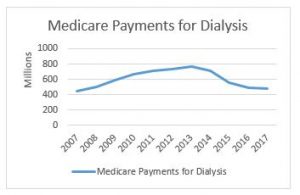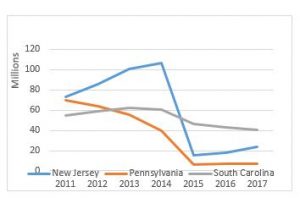HHS OIG Issues Proposed AKS Safe Harbor Rule
On Thursday, October 17, 2019, the HHS Office of the Inspector General (OIG) issued a proposed rule titled “Medicare and State Health Care Programs: Fraud and Abuse; Revisions to Safe Harbors Under the Anti-Kickback Statute, and Civil Monetary Penalties Regarding Beneficiary Inducements.” The proposed rule would amend the existing safe harbors to the Federal Anti-Kickback Statute (AKS) and the civil monetary penalty rules (CMPs). These changes are part of HHS’ Regulatory Sprint to Coordinated Care. The stated purpose of these changes is to reduce the regulatory barriers and accelerate the transformation of the healthcare system away from the traditional fee-for-service payment model, and towards a value-based system that rewards healthcare providers for better outcomes. The proposed rule can be viewed in its entirety at: https://www.govinfo.gov/content/pkg/FR-2019-10-17/pdf/2019-22027.pdf.
The proposed rule makes nearly a dozen major changes to the safe harbors under the AKS and the rules related to CMPs. Among these are revisions to the recently created safe harbor for local transportation. The proposed change to the safe harbor for free or discounted local transportation is discussed in greater detail below.
The OIG is soliciting comments on a wide range of topics raised in the proposed rule. The AAA is not taking any formal position with respect to the proposed changes or the requests for additional information set forth in this proposed rule. However, we encourage any member that wishes to comment to do so.
To be considered, comments must be submitted no later than 5 p.m. on December 31, 2019. Comments may be submitted electronically by going to: http://www.regulations.gov. Commenters would then need to click the link for “Submit a comment” and follow the instructions from there. Comments may also be submitted by courier or by regular, express, or overnight mail to the following address: Office of Inspector General, Department of Health and Human Services, Attention: OIG-0936-AA10-P, Room 5521, Cohen Building, 330 Independence Avenue SW, Washington, DC 20201.
Revisions to Safe Harbor for Free or Local Transportation
In 2014, the OIG created a new safe harbor for free or discounted local transportation provided to Federal health care program beneficiaries. This safe harbor applied to non-ambulance transportation (e.g., wheelchair van, bus and shuttle services, taxis, etc.) provided under the following conditions:
- The free or discounted transportation was provided by an “Eligible Entity.” For these purposes, an “Eligible Entity” is any individual or entity, other than individuals or entities (or family members or others acting on their behalf) that primarily supply health care items;
- The free or discounted transportation was provided pursuant to an existing policy of the Eligible Entity, and which is applied in a uniform and consistent manner;
- The transportation services are not air, luxury, or ambulance transportation;
- The Eligible Entity does not publicly market or advertise the free or discounted local transportation services, and no cross-marketing of other health care services occurs during the course of transportation, or at any time by the drivers providing such transportation. In addition, the drivers and anyone arranging the transportation cannot be paid on a per-beneficiary-transported basis;
- The transportation services are limited only to “established patients” of the Eligible Entity; and
- The transportation is limited to 25 miles in urban areas, or 50 miles in rural areas.
The safe harbor also permitted the use of “shuttle services” (i.e., a vehicle that runs on a set route, on a set schedule) if the following conditions are met:
- The shuttle service is not air, luxury, or ambulance-level transportation;
- The shuttle service is not marketed or advertised, and no cross-marketing occurs during the transportation, or at any time by the driver providing such transportation. In addition, the driver and anyone else arranging the transportation cannot be paid on a per-beneficiary-transported basis;
- The shuttle services has no stop that is more than 25 miles from any stop on the route where health care items or services are provided, except that this mileage restriction is expanded to 50 miles in rural areas.
In either situation, the safe harbor also requires the Eligible Entity to bear all costs of furnishing such transportation, i.e., they cannot shift that cost onto any Federal health care program, any other payer, or the individual.
In the current proposed rule, the OIG indicated that it received numerous comments from stakeholders that suggested that the 50-mile limit for residents of rural areas was insufficient, as many rural residents might need to routinely travel more than 50 miles to obtain certain medical services. As a result, the OIG is proposing to expand this limit to 75 miles.
The OIG is also soliciting comments on whether the proposed 75-mile is sufficient, or whether an even larger expansion is warranted. To the extent you intend to submit comments arguing for a greater mileage limit, the OIG is asking that you submit data or other evidence to support a more appropriate mileage limitation for the safe harbor. The OIG is also specifically requesting information on how an Eligible Entity would provide transportation over distances in excess of 50 miles (e.g., shuttle services, bus or taxi fare, ride-sharing programs, mileage reimbursement programs, etc.).
Expansion of Safe Harbor for Transportation of Patients Being Discharged After an Inpatient Stay
The OIG is also proposing to eliminate any mileage restriction on transportation of patients back to their residence after being discharged from a facility where that patient had been admitted as an inpatient, regardless of whether the patient resides in an urban or rural area. The OIG is also proposing to eliminate the mileage restrictions on discharges to another residence of the patient’s choice (such as a friend or relative who will care for the patient post-discharge).
The OIG further indicated that it is considering protecting transportation to other locations of the patient’s choice, including another health care facility. The OIG is soliciting comments on the potential fraud and abuse risks associated with permitting free or discounted transportation to other health care facilities, and whether transportation should be protected (and, if so, under what circumstances) when the patient has not previously been admitted to an inpatient facility (e.g., where the patient had been seen as an outpatient in a hospital emergency department). Finally, the OIG is soliciting comments on whether the transportation of patients being discharged beyond the applicable safe harbor mileage limitations should be limited to patients with demonstrated financial or transportation needs, and, if so, what standards should apply to such demonstration of need.
Possible Expansion to Include Transportation to Non-Medical Services
In the 2014 final rule creating the new safe harbor for local transportation, the OIG declined to extend the safe harbor protections to transportation for purposes other than obtaining medically necessary services or items (although they permitted a qualifying shuttle service to make stops at locations that do not relate to a particular patient’s medical needs). The OIG has since received numerous comments suggesting that the safe harbor should protect transportation for non-medical purposes that may nevertheless improve or maintain health, e.g., transportation to food banks, social services, exercise facilities, support groups, etc. The OIG indicated that it considering a further expansion of the safe harbor to include such non-medical needs, and is therefore seeking comments on how the safe harbor could be expanded to such needs without creating an unacceptable risk of fraud and abuse.
Clarification of Policy Regarding the Use of Ride-Sharing Services
Finally, the OIG is clarifying its interpretation of the applicability of the existing safe harbor to the use of ride-sharing services. In the preamble to the 2014 final rule, the OIG discussed the possibility that patient transportation might be provided via taxi. In the proposed rule, the OIG indicates that, while it did not explicitly reference ride-sharing services, it views these services are being similar to taxi services for the purposes of the safe harbor. Specifically, the OIG noted that nothing in the language of the safe harbor expressly precludes their use (or the use of self-driving cars or other similar technology that may become available at some point in the future). The OIG is inviting anyone that disagrees with this approach to explain the possible basis for exclusion of ride-sharing services.
The OIG did reiterate that the prohibition of the marketing of such free or discounted transportation would still apply. The OIG indicated that it would be permissible for ride-sharing services to advertise that they provide transportation to medical appointments, and to recommend that patients contact their medical providers to determine if they qualified for free or discounted transportation. By contrast, the OIG indicated that it would not be appropriate for the ride-sharing service to advertise that it provided free or discounted transportation to particular health care providers.
Other Changes in the Proposed Rule
In addition to the revisions to the existing safe harbor for free or discounted transportation, the OIG is proposing:
- The creation of three new safe harbors for participants in value-based arrangements that promote better coordinated and managed patient care. These include: (i) a safe harbor for Care Coordination Arrangements to Improve Quality, Health Outcomes, and Efficiency, (ii) Value-Based Arrangements with Substantial Downside Financial Risk, and (iii) Value-Based Arrangements with Full Financial Risk.
- The creation of a new safe harbor for certain tools and support furnished to patients to improve quality, health outcomes, and efficiency.
- The creation of a new safe harbor for remuneration provided in connection with CMS-sponsored models. The purpose of this new safe harbor is to eliminate the need for the OIG and CMS to issue model-specific waivers.
- The creation of a new safe harbor for donations of cybersecurity technology and services.
- Proposed modifications to the existing safe harbor for electronic health records items and services.
- Proposed modifications to the existing safe harbor for personal services and management contractors, in order to add flexibility with respect to outcomes-based payments and part-time arrangements.
- Proposed modifications to the existing safe harbor for warranties, to better address bundled warranties covering multiple health care items or services.
- The codification of the existing statutory exception for ACO Beneficiary Incentive Programs under the Medicare Shared Savings Program.
- A proposed amendment to the definition of “remuneration” under the CMP rules for certain telehealth technologies furnished to in-home dialysis patients.













